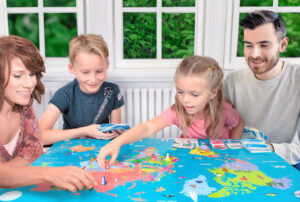
Here at Wicked Uncle, we encourage play, no matter what form that takes. But what if the pals your kids are playing with can’t be seen? Still a whole lot of fun!
So, let’s look at the official blurb – an imaginary friend is an invisible or personified companion created by children for company and play. It has been reported that up to 65% of children have had one before the age of seven. So, imaginary friends might actually be more common than you think!
Whether a fluffy mate with eight legs or a one eyed whimsical creature, they might live in a castle far far away or be a close confidant to tackle school worries. But whatever form they take, they can enrich children’s lives creatively, emotionally and socially.
To see how they can help your youngster, we’ve teamed up with Dr Adedeji Saheed, a practising medical doctor, to reveal some of the benefits of your child having an imaginary friend. Plus, we have some practical advice and even some facts you may not have known about along the way!
Early social benefits
Although imaginary pals may not exist, the short and long term benefits of having one are very real.
Research reported in Psychology Today found that children with imaginary companions are likely to be first-born or only children. So, when playtimes can get quiet and watching TV alone might not cut the mustard, playing with a fictional friend could minimise your child’s feelings of loneliness and aid conversation.
And when emotional regulation is still developing during childhood, a pretend pal can also be a great tool for children to learn how to cope with difficult things. Whether facing a new school, new class or new house, having an ear to listen and a shoulder to lean on – although you may not be able to see those ears or shoulders – of an imaginary buddy can help your child navigate any times of uncertainty.
Plus, away from any mean kids in the playground or clashing siblings, playing with their comforting mate can also provide a safe space for expressing their ideas and opinions.
“They offer companionship in moments when children might feel alone or misunderstood,” Dr Saheed says, “as imaginary friends don’t judge.” Imagine this – no pun intended – you can open up without the fear of rejection or backlash from any insensitive peers. Sounds good? It probably does for children too, which is another reason how a pretend pal could be great for learning how to communicate clearly.
Imaginary friends can also encourage a child to find, explore and sustain their interests early on – if your child is a big music fan, their buddy could be another fellow bandmate that brings out their inner rockstar. Dr Saheed says that commonly, “Imaginary friends often mirror the interests, experiences, and emotions of the child who invents them. This allows children to incorporate their passions and hobbies into their play,” allowing them to learn more of what they love! Also, a study published in the journal ‘Education & Child Psychology’ suggests that imaginary friends can represent the child’s “ideal self” or help “fulfil wishes” – so how your child describes their imaginary pal could tell you quite a bit about their ambitions!
Ace self-expression can be learnt with an imaginary friend as well. Does your child and their conjured up pal want to be knights fighting the Last Crusade? Chefs in a Michelin star kitchen? There’s no limits! Whatever the role they choose, your little one can express themselves and their creative vision fully. And, who knows, all that role-play could help shape some famous chefs in the making.
Later cognitive benefits
There are so many ways that our childhoods can shape us as we age, when we may not even realise it. Studies highlight how pretend pals can hone cognitive flexibility and development later in life because of the early skills first developed in play. Those like planning and organising, for example.
The role-play element of having an imaginary pal can also help this. As they learn how to navigate social situations and anticipate consequences, your child’s cognitive understanding can really grow. It’s been found that having an imaginary friend can help children understand the perspectives of others, as this article in Creative Child reports. It also offers a chance to “practise language skills such as vocabulary, grammar and storytelling,” Dr Saheed adds. “Pretend play with an imaginary friend allows children to practise important social skills like taking turns, negotiating, and empathising with others.” After all, we think setting up a restaurant with a cool menu or a busy gig from the comfort of your child’s bedroom is no easy feat, especially as a seven year old. And has your youngster’s new business venture got any angry customers or microphones not working on their world tour? No worries. Their imaginary friend can be on hand to help them with any problem solving.
Are there any drawbacks?
Your child having an imaginary friend may bring some potential frets. But, like anything, moderation and guidance can be helpful in keeping any worries at bay.
There’s very little need to worry about your child’s understanding of the divide between make believe and reality – this study from the American Psychological Association shows that children are well aware that their pal isn’t really there and that it’s just fun and games.
Feeling as though your kid is too reliant on an imaginary friend could arise. Have they blamed spilling juice on your new carpet or eating dessert before dinner – we’ve all been there – on their twinflame? “If a child blames their imaginary friend for misbehaviour or refuses to take responsibility for their actions by attributing them to their imaginary companion, it can hinder their ability to learn and grow from their experiences,” Dr Saheed adds. So, you might feel like this could do more harm than good when trying to teach your child the difference between right and wrong. But there’s no need to worry, as most children grow out of this phase at around eight or nine years old. If this does happen, though, we advise to not feel obliged to play along. This should still allow your son or daughter to engage in their fun whilst maintaining their independence and autonomy, and limit any potential harm.
An article in WebMD helpfully highlights one example of when to indulge your child’s make believe – putting out an extra plate at dinner for their imaginary friend is fine, but not throwing away that food because your kid says nobody else is allowed to eat it. This is a great example of how far to let the fantasy go.
Or, maybe their imaginary friend is the only one your child is playing with. This could cause worries about pausing developing social skills with real people. To encourage playtime – with real kids this time – Dr Saheed recommends gently encouraging your child “to participate in group activities, arranging play-dates with other children, or engaging in activities that promote social interaction and teamwork.” And there are lots of cool toys that can kickstart this fun with others, encouraging group play and the chance to practise any social skills your child has learnt with their imaginary friend! Testing out turn-taking and conflict resolution, planning an outdoorsy afternoon with the other neighbourhood kids or toying with construction kits for a rainy activity inside, could be next on the list of neat playdate ideas.
Now, we wanted to understand what some imaginary friends may look like, so we took to Reddit to see what its users have to say about some ‘made up pals’.
One user said their imaginary friend was a small bear-like creature the size of a six-year-old with long bat ears dressed in a red jumper and blue dungarees with gold buttons.
Let’s face it, we all want to see what this creature could look like. So, we took to Midjourney to create this imaginary friend – and we think it’s funny looking for sure, but also kind of cute!

Our very own boss, Mike, wanted to join in and shared that his imaginary friend was “a small solidly built, highly athletic koala bear, very cuddly and friendly, really good at climbing trees with a big smile and very calm and happy,”.
Want to see what this could look like? Here it goes.

We have to say, we’re very taken with Mike’s koala! He carried on, adding that he not only had a koala bear as an imaginary friend, but also a grizzly bear. He said: “It was a big ferocious grizzly bear living in the wardrobe who could come out and eat people I didn’t like or were generally mean. Right down to their shoes.”

Okay, we’re less keen on the grizzly bear – a bit scary! Though we can see how having a grizzly bear around to gobble up anyone who was mean to you would be great…
The final imaginary friend and a Midjourney creation is a bird-like creature another Reddit user described. “His wings would slump aside his wide thumpy like body. He had on overalls. Big chicken like feet that were worn down. His eyes small and all black”.

If an imaginary friend is not enough, one user on Reddit said they had an imaginary country. Fair to say that’s very creative.
The take aways
Seeing a pirate ship to explore when others see a cardboard box, kids could teach us a lot about how to think imaginatively, and even the joys of making friends that way too. We hope that this shows how exciting imaginary friends can be, and how they can help shape little minds just as much as real pals with parental guidance.



